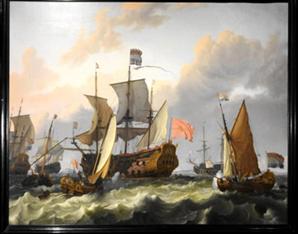Den Briel off Hellevoetisluis in Honour of the
Glorious Revolution of William III and City of Amsterdam
The Painting
During the mid-1600s, the British parliament feared the prospect of Catholic succession: King James II had converted to Catholicism, and married a Catholic woman with whom he had a male child who was required by the church to be raised as a Catholic. In addition, Parliament was distressed that King James II had taken steps to consolidate power into the Crown and away from Parliament. Consequently, a delegation of British peers invited William of Orange, a Dutch Prince, to invade England to restore protestant succession. Mary, William’s wife and a protestant, had been next in line to succeed to the throne of England before King James’ son was born.
William readily agreed to the scheme, for he had feared a British/French alliance that would allow France to invade the Netherlands and end its Republic. His British peers assured him that elements of the British military would defect to his cause as the invasion proceeded.
William of Orange and his wife Mary left Amsterdam aboard Den Briel, along with William’s armada of 463 ships and 15,000 troops. In November 1688, they reached the British coast. The flag flying in this painting reads “Pugmo Pro Patria”, which is Latin for “I fight for the Fatherland”. They were met with little resistance from the British army and no resistance at all from the Royal Navy. King James II and his family fled to France, upon which Parliament declared the throne vacant and offered it to William and Mary as co-monarchs. The event became known as “The Glorious Revolution” because their reign heralded the establishment of the constitutional monarchy that exists to this day.

